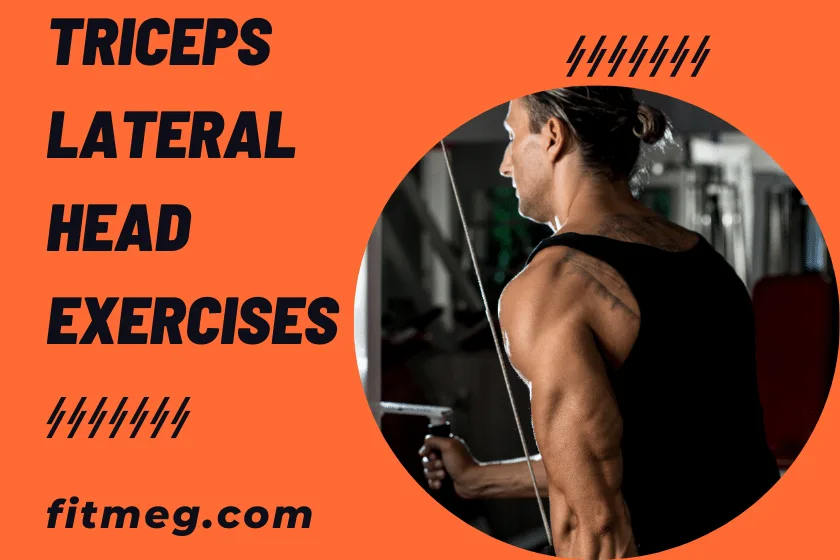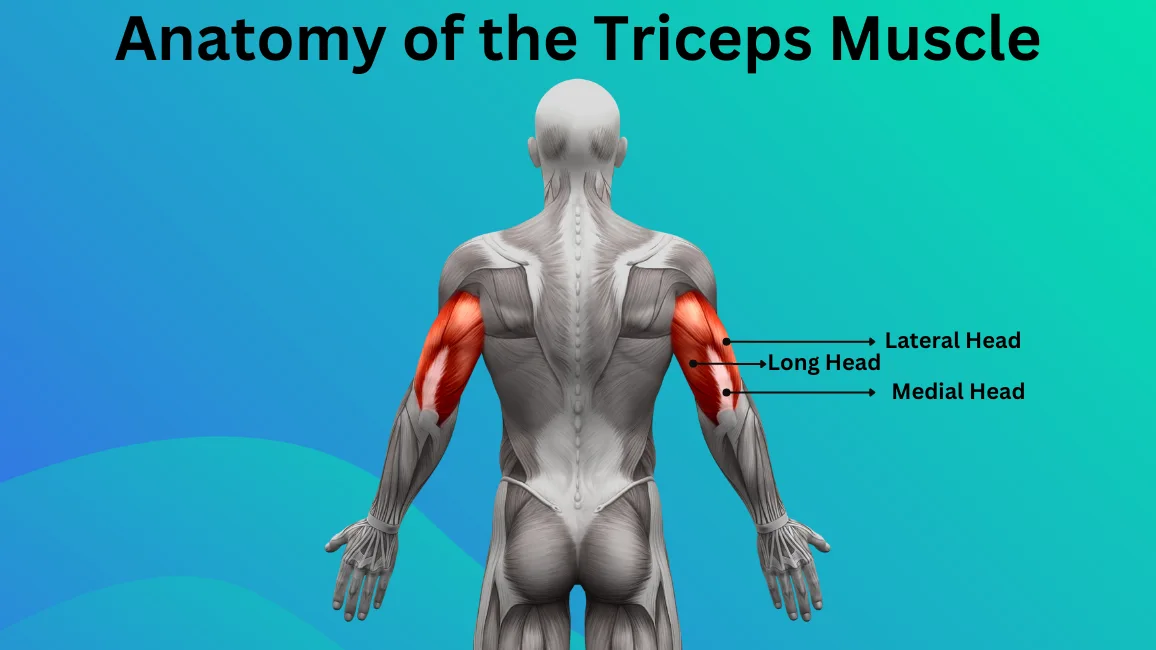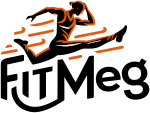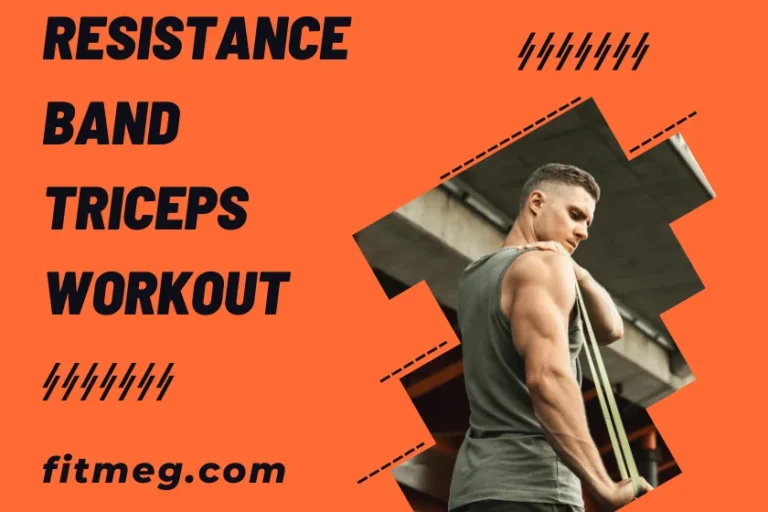Top 10 Triceps Lateral Head Exercises

If you want to build impressive, horseshoe-shaped triceps, you need to train the lateral head. The lateral head is one of the three heads of the triceps muscle, and directly contributes to the desirable aesthetic shape and outward bulge of the back of the upper arm. However, it is often neglected in training routines.
This comprehensive guide will provide you with detailed instructions of the Top 10 Triceps Lateral Head Exercises. By incorporating these moves into your workout program, you can enhance triceps development and sculpt the iconic horseshoe shape.
Anatomy and Function of the Triceps

The triceps is the large three-headed muscle located on the back of the upper arm. It makes up approximately two-thirds of the upper arm mass. The three heads of the triceps are:
- Lateral Head: Attaches to the rear-facing part of the humerus near the shoulder joint. Contributes significantly to the horseshoe shape of the triceps.
- Long Head: Attaches to the scapula and spans the entire upper arm. Helps extend the shoulder joint.
- Medial Head: Attaches to the rear-facing part of the humerus near the elbow joint. Aids elbow extension.
The main functions of the triceps are to extend the elbow joint and bring the forearm back towards the upper arm. It plays a major role in pushing, pressing and overhead arm movements.
The lateral head is recruited in arm movements where the palms face down or inwards. When performing triceps exercises with this hand position, it contributes significantly to the outward bulge and horseshoe shape of the muscle.
Also Read: Best 6 Upper Chest Workout With Cable
Why Target the Lateral Head?
There are two key reasons you should include lateral head exercises in your program:
Aesthetics – Directly training this overlooked head builds the iconic triceps horseshoe shape that is desirable for bodybuilders and physique competitors. You need to hit it from multiple angles for complete development.
Performance – The lateral head plays an important role in arm strength and power for pressing, pushing and overhead movements. A well-developed lateral head aids sports performance and lifts involving arm extension.
Now let’s get into the top exercises for sculpting impressive lateral head development!
Top 10 Triceps Lateral Head Exercises
1. Cable Crossover Triceps Extension
The Cable Crossover Triceps Extension is a versatile exercise that targets the triceps, particularly the lateral head. It’s performed on a cable crossover machine, which allows for a wide range of motion and constant tension on the muscles. The exercise involves extending the arms while keeping the elbows stationary, which isolates the triceps. It’s a great exercise for improving arm strength and enhancing muscle definition.
How to Perform:
- Attach D-handles to both the high and low pulleys of a cable machine.
- Grab the handles and stand in the middle facing one of the cables with feet shoulder-width.
- Extend your arms out to the sides so they form a “T” shape.
- Keeping elbows fixed, bring your hands towards each other in front of your body.
- Slowly return back to the starting position.
- Complete 3 sets of 12-15 reps.
This crossed arm movement directly targets the lateral triceps head. Keep the motion controlled and avoid swinging.
Benefits:
- Emphasizes outer triceps head with crossed extension pattern.
- Provides constant tension through a full range of motion.
- Allows for unilateral or single-arm training.
Mistakes to Avoid :
- Not maintaining proper form – It’s important to keep your torso upright and elbows tucked in at your sides throughout the movement. Avoid bending or arching your back.
- Not controlling the movement – Don’t use momentum or “swing” the arms to complete the reps. Keep the motion slow and controlled.
- Limited range of motion – Bring your hands in towards each other as far as comfortably possible to get a full contraction. Avoid partial reps.
Progression:
- Increase resistance by moving to a lower pulley position or using a heavier attachment
- Add an iso-hold at peak contraction
- Slow down tempo to increase time under tension
Variations:
- Single-arm: Perform one arm at a time
- Overhead: Press arms up overhead instead of straight out to sides
- Lying: Perform exercise lying on a bench
2. Diamond Push Ups
Diamond Push Ups are a challenging variation of the traditional push-up that places more emphasis on the triceps. The hands are placed close together on the floor, forming a diamond shape, hence the name. This positioning requires the triceps to work harder, making it an effective exercise for targeting the lateral head of the triceps. Diamond Push Ups are a bodyweight exercise, meaning they can be done anywhere, anytime.
How to Perform:
- Get into a standard push-up position with hands directly under your chest.
- Bring your hands closely together so the thumbs and index fingers touch to form a diamond shape.
- Keeping your core braced, lower yourself until your chest nearly touches the ground.
- Press back to the starting position, fully extending your arms.
- Aim for 3 sets of 8-12 repetitions.
Benefits:
- Hits multiple triceps heads, including the lateral head.
- Challenging move that builds impressive arm and chest strength.
- Convenient exercise that requires no equipment.
Progression:
- Increase depth: Work towards chest touching floor
- Elevate feet to increase resistance
- Add weight by using a weighted vest or plate on your back
Variations:
- Wide diamond: Hands slightly wider for more triceps focus
- Box diamond push-ups: Perform with hands on box to decrease range of motion
Mistakes to Avoid:
- Failing to keep hands in the diamond position throughout the move.
- Allowing hips to sag, compromising your lower back. Keep core engaged.
- Not going low enough – touch your chest to the floor for full range of motion.
3. Skull crushers
Skullcrushers, also known as lying tricep extensions, are a classic tricep exercise. Despite the intimidating name, Skullcrushers are a highly effective way to target the triceps, particularly the lateral head. The exercise involves extending the arms while holding a barbell, with the movement focusing on the elbow joint. This isolates the triceps, making Skull crushers a staple in many arm training routines.
How to Perform:
- Lie on a flat bench holding either a barbell or dumbbells above your chest with straight arms.
- Keeping upper arms stationary, bend elbows and lower the weight towards your head.
- Once you feel a stretch in the triceps, press the weight back up by extending your arms.
- Complete 3 sets of 10-12 controlled repetitions.
Benefits:
- Isolates the triceps, especially the lateral head.
- Allows use of heavier weights to overload the muscles.
- Provides a great stretch and peak contraction.
Mistakes to Avoid:
- Allowing elbows to flare out rather than keeping them tucked.
- Not going through a full range of motion – bring the weight close to your head.
- Using momentum rather than controlled form.
Progression:
- Increase weight amount when reps hit upper range
- Use slower eccentric tempo
- Add drop sets by reducing weight after muscle fatigue
Variations:
- Incline skullcrushers: Perform on an incline bench
- Overhead extension: Use cables or resistance bands
- Swiss ball: Lie head on ball to increase instability
4. Single Arm Pushdowns
Single Arm Pushdowns are a unilateral exercise that allows you to focus on one arm at a time. Performed on a high pulley machine with a single handle attachment, this exercise targets the triceps, particularly the lateral head. The unilateral nature of the exercise can help address any strength imbalances between the arms. It’s a great addition to any arm or upper body workout.
How to Perform:
- Attach a rope handle to the high pulley of a cable machine.
- Grab the rope with one hand and stand upright, taking a step back for tension.
- Keeping your upper arm stationary, bring the rope down by bending the elbow.
- Slowly return back to the starting position by straightening your arm.
- Complete 2-3 sets of 10-12 reps on each arm.
Benefits:
- Eliminates cheating by isolating one triceps at a time.
- Allows you to detect and address any strength imbalances.
- Provides constant tension from the cables.
Mistakes To Avoid:
- Allowing elbow flare – Keep your working elbow tucked in towards your side as you press down. Don’t let it flare outwards.
- Not stabilizing your core – Maintain a neutral spine by engaging your core. Avoid excessive arching of the lower back.
- Jerky form – Use smooth, controlled motions as you press the rope down, squeeze at the bottom, and return to the starting position. Don’t “yank” the rope.
Progression:
- Increase resistance by adding weight plates to rope attachment
- After reaching top of rep range, focus on increasing time under tension
Variations:
- Reverse grip: Twist hands so palms face upward
- Drop set: Reduce weight after hitting muscle failure on first set
5. Dumbbell Skull Crushers
Dumbbell Skull Crushers are a variation of the traditional Skullcrushers exercise, but performed with a dumbbell in each hand. This variation allows for a greater range of motion compared to the barbell version. The exercise targets the triceps, particularly the lateral head, and is a great way to add variety to your arm training routine.
How to Perform:
- Lie on a flat bench holding two dumbbells above your chest with arms extended.
- Without moving upper arms, bend elbows to lower the dumbbells back behind your head.
- Once you feel a stretch in the triceps, straighten arms to return to the starting position.
- Complete 3 sets of 10-12 controlled reps.
Benefits:
- Challenges lateral triceps head through a full range of motion.
- Allows each arm to work independently.
- Dumbbells provide instability for increased muscle activation.
Mistake to Avoid:
- Flaring elbows out as you lower the dumbbells – keep elbows tucked.
Progression:
- Increase dumbbell weight amount once top of rep range is reached
- Slow the eccentric portion of the lift
- Add rest-pause sets after completing all reps
Variations:
- Alternating: Perform one arm at a time, alternating
- Incline: Lie back on an incline bench
- Overhead extension: Perform starting with arms overhead
6. Side-Lying Triceps Extension
The Side-Lying Tricep Extension is a unique exercise that can be done with just a dumbbell. It involves lying on your side and performing the tricep extension movement. This exercise targets the triceps, particularly the lateral head, and is a great option for home workouts or when equipment is limited.
How to Perform:
- Lie on your side on a flat bench holding a dumbbell in the uppermost hand.
- Support your head with the free hand. The bottom elbow should be bent 90 degrees.
- Keeping the upper elbow tucked in, straighten your arm so the dumbbell goes up towards the ceiling.
- Bend the elbow to return to the starting position.
- Complete 2-3 sets of 10-12 controlled reps on each side.
Benefits:
- Hits the lateral triceps head from a unique angle.
- Prevents cheating by isolating one arm at a time.
- Provides a peak contraction when arm is fully straight.
Mistake to Avoid:
- Allowing upper elbow to flare out – keep it tucked in towards your side.
Progression:
- Increase dumbbell weight once reps reach upper range
- Hold peak contraction for 1-2 seconds
- Use slower tempo on the eccentric portion
Variations:
- Straight arm: Keep elbow locked and lift arm overhead
- Bent over: Perform bent over for increased stretch
- Across body: Bring dumbbell over torso to increase range of motion
Also Read: 10 Top Resistance Band Triceps Workout
7. Kettlebell Overhead Triceps Extension
The Kettlebell Overhead Tricep Extension is a dynamic exercise that targets the triceps, particularly the lateral head. The exercise involves extending the arms overhead while holding a kettlebell. The unique shape and weight distribution of the kettlebell provide a unique challenge, making this exercise a great way to mix up your arm training routine.
How to Perform:
- Stand upright while holding a kettlebell by the horns with both hands straight overhead.
- Maintaining a neutral spine, slowly lower the kettlebell behind your head by bending elbows.
- Press back to the starting position once you feel a stretch in the triceps.
- Complete 3 sets of 10-12 slow, controlled reps.
Benefits:
- Challenges triceps eccentric strength lowering the weight.
- Kettlebell forces extra stabilization in the shoulders and core.
- Works the lateral head directly in overhead position.
Mistake to Avoid:
- Letting elbows flare outwards – keep them tucked and close to your head.
Progression:
- Use a heavier kettlebell to increase resistance
- Pause at bottom stretch position
- Increase time under tension on eccentric
Variations:
- Seated: Perform sitting to decrease balance demands
- Single arm: Alternate arms performing one at a time
- Behind neck: Bring kettlebell behind head for more range
8. Close Grip Bench Press
The Close Grip Bench Press is a compound exercise that targets the triceps, chest, and shoulders. The hands are placed closer together on the barbell, which places more emphasis on the triceps, particularly the lateral head. The Close Grip Bench Press is a great exercise for building overall upper body strength and size.
How to Perform:
- Lie back on a flat bench holding a barbell with a close grip, about shoulder width apart.
- Lower the bar slowly to your mid-chest, keeping elbows tucked in.
- Press the bar back up until your arms are fully straight.
- Focus on controlled form for 3-4 sets of 6-8 reps.
Benefits:
- Heavy compound exercise overloads all triceps heads.
- Close grip enhances recruitment of the lateral head.
- Builds impressive triceps strength.
Mistake to Avoid:
- Allowing elbows to flare outwards – keep them tucked close to your body throughout the press.
Progression:
- Increase weight once top reps are achieved
- Add chains or bands for accommodating resistance
- Incorporate rest-pause sets after muscle fatigue
Variations:
- Board press: Place board on chest to decrease range of motion
- Incline press: Use an incline bench to shift emphasis
- Dumbbells: Use dumbbells instead of barbell
9. Tricep Pressdowns
Tricep Pressdowns are a popular exercise for targeting the triceps, particularly the lateral head. The exercise is performed on a high pulley machine with a bar attachment and involves pushing the bar down to fully extend the arms. Tricep Pressdowns are a staple in many arm training routines due to their effectiveness and ease of use.
How to Perform:
- Attach a straight bar to the high pulley of a cable machine.
- Grab the bar with an overhand grip, then stand upright.
- With arms extended, bring the bar down by bending elbows and pressing forearms into thighs.
- Slowly return to the starting position by straightening arms.
- Complete 3 sets of 12-15 controlled reps.
Benefits:
- Isolates and fatigue the triceps, especially the lateral head.
- Cable resistance provides constant tension.
- Can perform one arm at a time or various grips/bars.
Mistake to Avoid:
- Allowing elbows to move away from your sides – keep them fixed as you press down.
Progression:
- Move to lower pulley position to increase resistance
- Slow tempo on eccentric phase
- Use double progression model adding weight once reps hit top range
Variations:
- V-bar or rope attachment: Use different attachments
- Overhead: Press down from overhead position
- Single-arm: Train one arm at a time
10. EZ-Bar Overhead Triceps Extension
The EZ-Bar Overhead Triceps Extension is an effective exercise for targeting the triceps, particularly the lateral head. The unique shape of the EZ-Bar allows for a comfortable grip, which can reduce strain on the wrists and elbows. This exercise involves extending the arms overhead while holding the EZ-Bar, which isolates the triceps and provides a great stretch. It’s a fantastic addition to any arm training routine, offering a different challenge compared to other tricep exercises.
How to Perform:
- Stand upright while holding an EZ-curl bar with a close grip overhead. Arms should be straight.
- Without moving upper arms, bend elbows and lower the bar behind your head.
- Once you feel a stretch in the triceps, press the bar back overhead by straightening arms.
- Complete 3 sets of 10-12 controlled reps.
Benefits:
- Hits all triceps heads, targeting the lateral head directly.
- EZ-bar is easier on the wrists compared to straight bar.
- Can perform one arm at a time.
Mistake to Avoid:
- Swinging the weight up using momentum rather than controlled form.
Progression:
- Increase weight once you can complete all reps with proper form
- Add tempo focus, slowing the eccentric portion
- Use rest-pause sets, racking the bar after initial muscle failure and continuing reps
- Increase time under tension by holding the peak contraction
Variations:
- Seated: Perform sitting to isolate triceps more
- Behind the neck: Allows for greater stretch and range of motion
- Single arm: Alternate performing one arm at a time
- Reverse grip: Twist hands so palms face forward
- Drop set: Reduce weight after hitting muscle failure on first set
- Bottoms up: Begin with arms overhead and lower behind back
- Arnold press: Begin by pressing bar overhead before lowering behind head
Also Read: Top 10 Forearm Workout Tools And Equipment
Integrating Lateral Head Exercises into Your Workout Routine
Now that you have a comprehensive list of the top lateral head tricep moves, it’s time to effectively integrate them into your regimen. Here are some tips:
- Train triceps 2-3 times per week for best results. Ensure you recover properly between sessions.
- Include a mix of isolation exercises (kickbacks, extensions) and compound moves (close grip bench, dips).
- Perform multi-joint moves first when triceps are fresh. Do isolation exercises afterwards.
- Use a challenging weight that allows you to complete all sets/reps with proper form. Increase the weight as you get stronger.
- Vary your grip – using different bars, dumbbells, single arm, reverse grip, etc. keeps development even.
- Pair triceps training with pushing exercises like chest and shoulders that also utilize the triceps as secondary movers. But don’t overtrain them.
- Ensure you are eating enough protein (0.5-1g per pound of bodyweight daily) to promote triceps growth and recovery.
Conclusion
If you want to build bigger, stronger triceps, it is crucial that you incorporate specific lateral head exercises into your routine. This will develop the iconic horseshoe shape and outward bulge of the muscle.
Use this guide to add new lateral-head focused moves into your program. Train them hard consistently, allow for proper recovery, and provide your body with adequate nutrition. If you target the lateral head directly 2-3 times per week, you will be blown away by your triceps development!
Frequently Asked Questions (FAQs)
Q) Which tricep exercises hit lateral head?
A) Exercises that emphasize shoulder extension, such as overhead extensions, unilateral extensions, and kickbacks, are best for targeting the lateral triceps head. Pushing motions away from the body tend to isolate the lateral head.
Q) How do you activate lateral head?
A) To better activate the lateral triceps head, use a narrower grip on pressing moves. Flaring the elbows out more will also increase emphasis on the lateral head. Try overhead dumbbell extensions with a neutral grip.
Q) How do you isolate lateral tricep head?
A) The best way to isolate the lateral triceps head is to perform unilateral exercises such as single-arm overhead extensions or kickbacks. Keeping the upper arm stationary emphasizes the lateral head.
Q) Do skull crushers hit the lateral head?
A) Not significantly. Skull crushers primarily target the long and medial triceps heads. The lateral head is less involved in this movement due to the shoulder joint staying more stable.
Q) Which tricep head is the biggest?
A) The long head is typically the largest of the three triceps heads. The lateral head is usually the smallest head, while the medial head is intermediate in size compared to the long and lateral portions.

